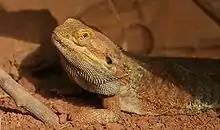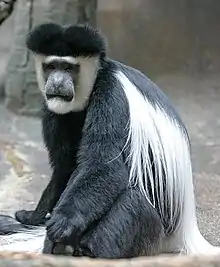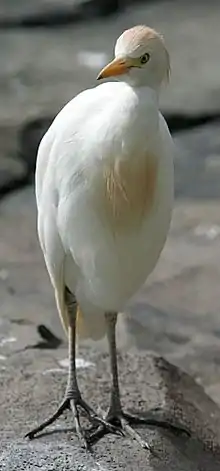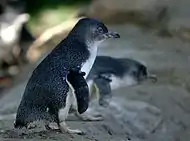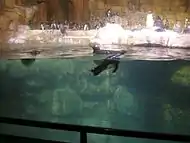Henry Doorly Zoo and Aquarium
Omaha's Henry Doorly Zoo and Aquarium is a zoo in Omaha, Nebraska, located at 3701 South 10th Street. It can be accessed by I-80.[4] It is accredited by the Association of Zoos and Aquariums and a member of the World Association of Zoos and Aquariums. Its mission is conservation, research, recreation, and education.[5] In August 2014, TripAdvisor proclaimed Henry Doorly Zoo the "world's best zoo", leading San Diego Zoo and Loro Parque, based on an algorithmic assimilation of millions of reviews for 275 major zoos worldwide.[6]
 | |
 Sign at the main entrance | |
| Date opened | 1894 as Riverview Park Zoo |
|---|---|
| Location | Omaha, Nebraska, United States |
| Coordinates | 41.224703°N 95.928701°W |
| Land area | Over 130 acres (53 ha)[1] |
| No. of species | 962[1] |
| Annual visitors | ~2,000,000 |
| Memberships | AZA,[2] WAZA[3] |
| Major exhibits | Lied Jungle, Desert Dome, Kingdoms of the Night, Scott Aquarium, Cat Complex, Hubbard Gorilla Valley, Hubbard Orangutan Forest, African Grasslands |
| Website | www |
Omaha's Henry Doorly Zoo and Aquarium is nationally renowned for its leadership in animal conservation and research. Evolving from the public Riverview Park Zoo established in 1894, today the zoo includes several notable exhibits. It features the largest cat complex in North America;[7] "Kingdoms of the Night" is the world's largest nocturnal exhibit and indoor swamp;[7] the Lied Jungle is one of the world's largest indoor rainforests, and the "Desert Dome" is one of the world's largest indoor deserts,[8] as well as the largest glazed geodesic dome in the world.[9][10] The zoo is Nebraska's top paid attendance attraction and has welcomed more than 25 million visitors over the past 40 years.
History
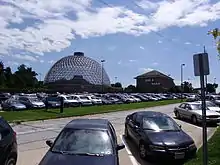
The zoo originally began in 1894 as Riverview Park Zoo. Four years later, it had over 120 animals. In 1952, the Omaha Zoological Society was created with aims to improve the zoo. In 1963, Margaret Hitchcock Doorly donated $750,000. In doing so, she stipulated that the zoo be renamed in memory of her late husband, Henry Doorly, chairman of the World Publishing Company. Union Pacific helped the zoo lay down 2.5 mi (4.0 km) of track in 1968 with the inaugural run of the Omaha Zoo Railroad made on July 22, 1968.[11]
Omaha's Henry Doorly Zoo and Aquarium has two rides that circumnavigate the zoo (tram and train), a carousel and the Skyfari, an aerial tram which opened in 2009 and which takes visitors from the Butterfly and Insect Pavilion to the new lion viewing exhibit.
The zoo is adjacent to the former site of Rosenblatt Stadium. In 2011, the zoo began developing the land at former Rosenblatt Stadium to become the new parking area and visitor center, leaving a small memorial at the location of home plate. Rosenblatt was replaced by the new TD Ameritrade Park downtown.
Zoo history timeline
This is a selected list of when buildings and exhibits were created:
- 1894: Riverview Park opened.
- 1898: The park had a varied animal population of over 120 animals.
- 1920s : Gould Dietz donated cat cages.
- 1930s : The WPA built cat and bear exhibits.
- 1952: The Omaha Zoological Society was organized for the improvement and administration of the zoo.
- 1963: Margaret Hitchcock Doorly donated $750,000 to the zoo with the stipulation that the zoo be named after her late husband, Henry Doorly.
- 1965: The Omaha Zoological Society was reorganized as a nonprofit organization, and the first phase of the zoo, which included bear grottos, gorilla and orangutan buildings, and Ak-sar-ben Nature Kingdom, was dedicated.
- 1968: The inaugural run of Omaha Zoo Railroad was in July, and the Eugene C. Eppley Pachyderm Hill opened in November on the old baseball diamond site.
- 1972: The Ak-Sar-Ben waterfall was constructed; in August, the Owen Sea Lion Pavilion opened, complete with a new concession building, public restrooms, and a gazebo where an old public swimming pool was located.
- 1973: Owen Swan Valley and the Primate Research Building were completed.
- 1974: A new diet kitchen and educational classrooms were completed.
- 1977: The Cat Complex was added.
- 1979: The hospital and nursery opened.
- 1981: The giraffe and hoofstock complex opened.
- 1983: The Lee G. Simmons Free-flight Aviary was completed.
- 1984: A 70,000-US-gallon (260,000 l; 58,000 imp gal) saltwater aquarium opened in what had been the museum.
- 1985: The gorilla and orangutan buildings were completely renovated and named in honor of the Owen family; Richard Simmons cut the ribbon.
- 1986: World-Herald Square was completed, and the First Tier Wolf Woods, maintenance building, and hay barn were relocated to the northeast.
- 1987: The Mutual of Omaha Wild Kingdom Pavilion, the visitor services area US West Plaza, and a new main entrance were finished.
- 1988: Construction began on the Lied Jungle, and the zoo was selected for the endangered black-footed ferret breeding program. The zoo's greenhouse was built near the maintenance shop.
- 1989: Durham Family's Bear Canyon was added; Doorly's Pride (a heroic bronze sculpture of a pride of 12 lions) was installed in the entry plaza area, and the zoo received the prestigious AAZPA Bean Award for its long-term gaur propagation efforts. The black-footed ferret building was constructed.
- 1990: Dairy World featuring a children's petting zoo, educational exhibits, and concession area, was added, and the world's first in vitro-fertilized tiger was born at the zoo.
- 1991: The Birthday House for children's birthday parties and education classes was finished; the world's first artificially inseminated tiger was born at the zoo.
- 1992: The Lied Jungle opened on April 4, with the attached Durham's TreeTops Restaurant and Education Center. Simmons Plaza near the main entrance was completed.
- 1993: The old aquarium was closed and construction of the new aquarium began. The zoo received two AAZPA awards: the Conservation Award for its black-footed ferret management program and the Significant Achievement Award for the Lied Jungle. The world's first artificially inseminated gaur calf was born at the zoo.
- 1994: The Union Pacific Engine House for the Omaha Zoo Railroad was added.
- 1995: The Walter and Suzanne Scott Kingdoms of the Seas Aquarium was opened. The zoo had more than 1.6 million visitors, and land was acquired for an off-site breeding facility and drive-through park. Construction began on the IMAX 3D Theater, and the zoo participated in the propagation of the world's first in vitro gorilla birth (Timu was born at the Cincinnati Zoo).
- 1996: The Bill and Berniece Grewcock Center for Conservation and Research was completed, and Timu, the world's first in vitro gorilla moved to Omaha's zoo.
- 1997: The Lozier IMAX theater was finished.
- 1998: The Garden of the Senses, the Lee G. Simmons Conservation Park and Wildlife Safari (22 mi (35 km) west at Nebraska's I-80 Exit 426 near Ashland), and a new diet kitchen were completed, and construction began on a new pathology laboratory and keepers lounge.
- 1999: Sue's Carousel was added, construction began on the world's largest desert dome, and the zoo hosted a temporary Komodo dragon exhibit.
- 2000: The new North Entrance Plaza was completed, featuring a new gift shop, warehouse, entrance plaza, and visitor gazebo. The zoo joined the Okapi Species Survival Program, allowed it to be one of only 14 zoos in North America to display rare okapi; a traveling koala exhibit visited the zoo.
- 2001: Cheetah Valley, and new bongo and tree kangaroo exhibits were constructed, and the zoo hosted a traveling white alligator exhibit.
- 2002: Desert Dome was finished, and construction began on Hubbard Gorilla Valley.
- 2003: Kingdoms of the Night, featuring various nocturnal habitats, opened beneath the Desert Dome.
- 2004: Hubbard Gorilla Valley was opened, and a tower with two high-capacity elevators were added to take visitors from the main level of the zoo near the Desert Dome down 44 ft. to Hubbard Gorilla Valley.
- 2005: The Hubbard Orangutan Forest opened in two phases in May and August; a giraffe feeding station opened in the spring; and construction began on an addition to the Grewcock Center for Conservation and Research.
- 2006: A new Guest Services building and two additional gates at the main entrance were added; the Hubbard Research wing expansion to the Grewcock Center for Conservation and Research opened in July; and the Budgie Encounter was finished.
- 2007: Mutual of Omaha's Wild Kingdom Pavilion was transformed into the Exploration Station, and construction on the Butterfly and Insect Pavilion began.
- 2008: The Berniece Grewcock Butterfly and Insect Pavilion opened; and construction on a Madagascar exhibit began.
- 2009: Skyfari, a chairlift connecting the Butterfly and Insect Pavilion to the old African rangeland exhibit area.
- 2010: Expedition Madagascar opened.
- 2012: Scott Aquarium is reopened after renovations, Rosenblatt Stadium is demolished by the zoo, and the zoo is official renamed Omaha's Henry Doorly Zoo and Aquarium.
- 2013: A new gift shop opened, the IMAX facility was remodeled, and the Infield At The Zoo and Gateway to the Wild exhibits were completed.
- 2014: Stingray Beach opened to the public. The seasonal interactive exhibit, located by Sue's Carousel, provides visitors the opportunity to touch and feed cownose, Atlantic and Southern stingrays. Camel rides, also located by Sue's Carousel, opened to the public. Construction on Omaha's Henry Doorly Zoo and Aquarium's largest project to date, the African Grasslands, began."[12]
- 2016: Six African elephants arrived at the zoo from Eswatini to escape a drought on March 11.[13] On May 27, the African Grasslands opened after two years of construction. This, coupled with Memorial Day weekend, caused what local media dubbed "Zoopocalypse". Within two hours of opening the zoo saw over 8,000 visitors enter the main gates; a normal Sunday sees 4–5,000 people all day. Hours later, the entrance count was up to over 20,000 people.
- 2017: Warren the African elephant tragically dies. He was the only male of the six African elephants that arrived at this zoo from Eswatini.[14]
- 2018: Bay Family Children's Adventure Trails opens.
- 2019: The Birmingham Zoo's male African elephant Callee joins the herd to breed with its five female African elephants.
- 2020: Owen Sea Lion Shores Attraction opened on September 4.[15]
Major exhibits
African Grasslands
After six years of planning and three years of construction, the 28-acre, $73 million African Grasslands exhibit opened to the public May 27, 2016, over the zoo's former eastern boundary area and Pachyderm Hill exhibits. The exhibit is the zoo's largest project to date, with over twenty five new buildings, in addition to multiple wildlife panoramas and a Kopje, and features giraffes, hoofstock, white rhinos, and many other native species including six African elephants in a 29,000-square feet exhibit that is the largest herd room in North America. There are a variety of new structures for guests, such as a hunting lodge-inspired Grill, the exploration-based Wildlife Management Headquarters, tents for overnight visits, and a Giraffe Encounter where guests may feed giraffes.[16] In May 2019, the Birmingham Zoo's male African bush elephant Callee joined the herd of five female elephants to breed with them.[17]
Highlighted species include:
Asian Highlands
A new exhibit built on previously undeveloped space the Asian Highlands area is a $22 million, 8-acre recreation of the highlands of central Asia, including India and China designed to simulate a mountain ascent, featuring species native to the region as well as a Yeti Camp, acting as a hub for visitors with themed food and gift options, and a Kid's Discovery Trail as well.[18] The first phase of the exhibit opened in the spring of 2018 and the second phase opened in the spring of 2019.[19]
Butterfly and Insect Pavilion
The Berniece Grewcock Butterfly and Insect Pavilion opened in 2008. The Pavillion is a 14,000-square-foot (1,300 m2) total-immersion exhibit located between the Scott Aquarium and the Giraffe Complex. Viewed from the sky, the exhibit resembles a winged insect. The building features several different exhibits inside:
- Butterfly Conservatory: The 2,450-square-foot (228 m2) area features 10-foot (3.0 m)-high glass sidewalls to allow the maximum amount of light inside the exhibit. Natural light, large trees, rocks, and water elements are all critical components needed to simulate a natural habitat and important to stimulate natural butterfly behaviors.
- Conservation Promenade: Located in the Butterfly Conservatory, the promenade winds past numerous waterfalls and over streams, through lush vegetation, and loops around the giant Amazon water lily pool. The pool features a stilt root tree supporting a floating walkway for visitors to travel through the roots and get an up-close view of the giant South American water lilies. Many species of exquisite butterflies and moths including the beautiful blue morpho, zebra longwing, and painted ladies fly among visitors. Microhabitats will be displayed along the Conservation Promenade featuring many endangered amphibians the Zoo is currently working with in response to the global amphibian crisis. Upon leaving this area, visitors will find a mirrored room to carefully check for hitch-hiking butterflies before exiting.
- Chrysalis Hatching Room: A 220-square-foot (20 m2) area where butterflies and moths in their chrysalis or cocoon stage will be brought in from all over the world. Once inside, they will be carefully hung in hatching chambers where visitors can watch them complete their metamorphosis into flying insects. The 510-square-foot (47 m2) entry hallway leading into the insect wing will contain several displays, such as a locust colony and bee hive, along with interactive learning opportunities.
- Insect Zoo: This 2,413-square-foot (224.2 m2) area will have a 5-foot (1.5 m) high glass sidewall on top of a 7-foot (2.1 m) solid wall to allow more intensive exhibit work. Individual micro-habitats will be home to ants, spiders, scorpions, walking sticks, mantids, centipedes, roaches, beetles and other creatures. In the center of this experience, two bird cages will house other exotic species such as tropical hummingbirds.
- Lower Level: Features two rooms, approximately 1,085-square-foot (100.8 m2) total, to be used for rearing butterflies and culturing insect colonies. A 542-square-foot (50.4 m2) room will be used to maintain plants that are being rotated through the butterfly display. A frog breeding and rearing facility occupying 1,161-square-foot (107.9 m2) of space, will house the most threatened amphibians. The rooms will be viewed through windows from the Giraffe Observation Walk that circles the building and will allow Zoo visitors a real look at what goes on behind the scenes. This same path will have numerous native butterfly gardens and offer visitors the opportunity to be eye to eye and nose to nose with the giraffe herd. -->
Desert Dome
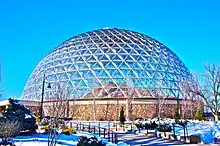
The Desert Dome opened in April 2002 at a cost of $31.5 million (includes Kingdoms of the Night). It is one of the world's largest indoor deserts at around 42,000 ft2 (0.96 acres; 3,900 m2).[20] Beneath the Desert Dome is the Kingdoms of the Night, and both levels make up a combined total of 84,000 sq ft (1.9 acres; 7,800 m2). The Desert Dome has geologic features from deserts around the world: Namib Desert of southern Africa, Red Center of Australia, and the Sonoran Desert of the southwest United States.
Animals include:
.jpg.webp)
- Central bearded dragon (Pogona vitticeps)
- Collared peccary (Tayassu tajacu)
- Greater roadrunner (Geococcyx californianus)
- Desert cottontail
- Swift fox (Vulpes velox)
- Cape thick-knee (Burhinus capensus)
- Venomous snakes
- Wallaby
- Meerkat
- Coatimundi
- Hummingbirds
- Ocelot
- Bat-eared fox
- Klipspringer
In addition to being one of the world's largest indoor deserts, the Desert Dome's geodesic dome is also the world's largest 'glazed' geodesic dome. The dome is 137 ft (42 m) above the main level and 230 ft (70 m) in diameter. The 1,760 acrylic windows with four shades (some clear) were placed to allow maximum shade in the summer and maximum light in the winter to reduce energy costs.[20]
Expedition Madagascar
Expedition Madagascar opened May 7, 2010, and has many animals including lemurs, straw-coloured fruit bats, and giant jumping rats. The building of Madagascar gives the visitors a chance to learn more about an area of the world considered one of the top hotspots for biodiversity because it is home to the largest number of endemic, native only to this country, plant and animal species. Throughout the building, each exhibit is linked to ongoing projects in Madagascar.
Garden of the Senses

The Garden of the Senses opened in spring 1998 at a cost of $1.8 million. The garden is filled with plants, fountains, birds, a giant sundial, and more. Over 250 different species of herbs, perennials, and trees, as well as roses and other flowers, butterfly-friendly plants, and trellises. The birds include macaws, South American parrots, and Australian cockatoos.
Hubbard Gorilla Valley
The Hubbard Gorilla Valley is a gorilla exhibit named after Dr. Theodore Hubbard (a cardiologist from Omaha). It opened on April 8, 2004, at a cost of $14 million. Prior to being expanded and rebuilt, the Hubbard Gorilla Valley was the Owen Gorilla House.
Some of the animals included are:
- Mantled guereza (Colobus guereza)
- Western lowland gorilla (Gorilla gorilla gorilla)
- Wolf's mona monkey (Cercopithecus wolfi)
- Diana monkey (Cercopithecus diana)
- Abyssinian ground hornbill (Bucorvus abyssinicus)
- Yellow-backed duiker (Cephalophus silvicultor)
- Black crowned crane (Balearica pavonina)
Hubbard Orangutan Forest
The Hubbard Orangutan Forest opened in two phases during 2005; the first phase was opened in May, and the second phase opened in late summer at a cost of $8.5 million. The first phase is the outdoor habitat that includes two 65-foot (20 m)-tall, 100-short-ton (91-metric-ton) Banyan trees interconnected with vines enclosed by a stainless steel netting.
A 20-foot (6.1 m) waterfall is named after Claire Hubbard, the Orangutan Forest's primary donor. The second phase, the indoor habitat has 3,126 ft2 (0.07 acres; 290 m2). The majority of animals are primates which include the following:
- Bornean orangutan (Pongo pygmaeus)
- Siamang (Symphalangus syndactylus)
Kingdom of the Seas Aquarium

The Walter and Suzanne Scott Kingdoms of the Seas Aquarium, a public aquarium, opened on April 1, 1995, at a cost of $16 million.[21] The building has 71,000 sq ft (6,600 m2) and contains a total of 1,200,000 US gal (4,500,000 l; 1,000,000 imp gal) of water.[22] The exhibit was first renovated in 2011, and opened again on April 5, 2012. As of 2020, the exhibit's bathroom and concession stand are currently undergoing renovations.
It features displays of aquatic habitats from polar regions, temperate oceans, the flooded Amazon rainforest, and coral reefs. The 450,000 US gal (1,700,000 l; 370,000 imp gal) shark tank features a 70 ft (21 m) shark tunnel at the bottom of the 17 ft (5.2 m)-deep tank.[22] This tank features sharks, stingrays, sea turtles, and coral reef fish. Other tanks include a jellyfish, and open-ocean schooling fish. A new addition is a portable touch tank which allows visitors to feel a shark's scales and the rubbery skin of a stingray. The only freshwater display is of the Amazon rainforest that includes fish, invertebrates, turtles, and mammals (including common squirrel monkeys).
The aquarium features aquatic animals from around the world, including:
- Tufted puffin (Fratercula cirrhata)
- Little penguin (Eudyptula minor)
- King penguin (Aptenodytes patagonicus)
- Gentoo penguin (Pygoscelis papua)
- Pufferfish
- Moray eel
- Coral reef
- Sharks
- Stingray
- Sea turtle
- Jellyfish
Kingdoms of the Night

The Eugene T. Mahoney Kingdoms of the Night opened beneath the Desert Dome in April 2003 at a cost of $31.5 million (includes Desert Dome). Kingdoms of the Night is the world's largest nocturnal animal exhibit [20] at 42,000 ft2 (0.96 acres; 3,900 m2). Both the Kingdoms of the Night and the Desert combine to a total of 84,000 sq ft (1.9 acres; 7,800 m2). The Kingdoms of the Night features a wet cave (with a 14 ft or 4.3 m deep aquarium), a canyon, an African diorama, a eucalyptus forest, a dry batcave, and a swamp. The swamp is also the world's largest indoor swamp.[23] A Kingdoms of the night logo is a sign that has the owl eyes.
Some of the animals found at the Kingdom of the Night include:
- Fossa (Cryptoprocta ferox)
- Aardvark (Orycteropus afer)
- Bats
- American alligators, including a white individual (one of less than 15 in the world)
- Greater bushbaby
- Beaver
- Bushy-tailed jird
- Blind cave fish
- Prehensile-tailed porcupine
- Three-banded armadillos
Lied Jungle

The Lied Jungle opened on April 4, 1992, at a cost of $15 million.[24] It is one of the largest indoor rainforest exhibits in the world; it occupies an 80-foot (24 m) tall building that spans 1.5 acres (0.61 ha) and is located just inside the main entrance. This exhibit allows visitors to look out from behind a 50-foot (15 m)-tall waterfall.
Inside are 123,000 ft2 (2.82 acres; 11,400 m2) of floor space, of which 61,000 ft2 (1.4 acres; 5,670 m2) are planted exhibit space; 35,000 ft2 (0.8 acres; 3,250 m2) are a display management area; and 11,000 ft2 (0.25 acres; 1,020 m2) are an education area.[24]
Visitors can walk along a trail on the floor of the jungle, as well as on a walkway around and above the animals. Both levels are split into sections by continent, including Asia, Africa, and South America. Along both trails, about 90 species can be found, including:
- Blue monkey (Cercopithecus mitis)
- Common squirrel monkey (Saimiri sciureus)
- Black howler monkey (Alouatta caraya)
- Pygmy hippopotamus (Choeropsis liberiensis)
- Scarlet macaw (Ara macao)
- Baird's tapir (Tapirus bairdii)
- Indian crested porcupine
- Gibbon
- Otter
- Cichlid
- Philippine crocodile (Crocodylus mindorensis)
Ring-tailed lemurs, red ruffed lemurs, and black-and-white ruffed lemurs used to be on display in the Lied Jungle, but were moved to the Expedition Madagascar exhibit upon its opening in 2010.
Notable points
Visitors to the jungle can view the indoor jungle through 90 ft (27 m) of floor-to-ceiling windows at the Durham's TreeTops Restaurant, which is next to the jungle. A portion of the electrical power needed for the jungle is provided by natural gas fuel cells. The jungle has won several awards, including "Single best zoo exhibit in the country" in 1994 by the Family Life Magazine; "Significant Achievement Award for Exhibit Design" in 1993 by the American Association of Zoological Parks and Aquariums; "Top ten designs in the world" in 1992 by Time, and "Top eight US engineering accomplishments" in 1992 by the National Society of Professional Engineers[25]
 Blue monkey
Blue monkey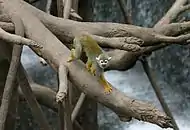 Common squirrel monkey
Common squirrel monkey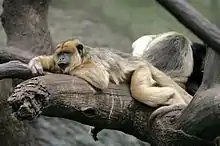 Black howler monkey
Black howler monkey Malayan tapir (with calf)
Malayan tapir (with calf)
Owen Sea Lion Shores
The Owen Sea Lion Shores opened on September 4, 2020, costing $27.5 million.[15][26] The one-acre exhibit replaced the Durham Family Bear Canyon, and the smaller Owen Sea Lion Pavilion. It features a 275,000-gallon saltwater pool with natural wave chambers, shallow beaches for young pups learning to swim, fish feeders that release fish and calamari at random times and places in the exhibit encouraging hunting behavior, a shaded seating area with a capacity of up to 170, and an underwater viewing cavern.
Simmons Aviary
The Simmons Aviary opened in 1983, and is the world's third-largest free-flight aviary. It is home to about 500 birds from around the world. In this 4-acre (16,000 m2) exhibit, visitors see flamingos, ducks, swans, storks, cranes, spoonbills, ibis and egrets. The Aviary is 800 feet (240 m) long and rises to 75 feet (23 m) at the center. The structure is covered with 142,000 sq ft (13,200 m2) of two-inch nylon mesh that is supported by a system of cables and poles. The use of nylon instead of wire is a unique concept.[27] In 2020, the Aviary closed for renovations.
The Wild Kingdom Pavilion
Situated inside the zoo's main entrance, the 21,000-square-foot (2,000 m2) Mutual of Omaha's Wild Kingdom Pavilion was completed in the spring of 1987. The building currently houses reptiles, insects, amphibians, and small mammals, while also providing business offices, a 312-seat multimedia auditorium, and classrooms.
The Wild Kingdom Pavilion has been transformed into the Exploration Station exhibit, serving as a safari-themed “Trail Head” where visitors begin their “wild” adventure at Omaha's zoo. Mutual of Omaha's Exploration Station includes a detailed interactive map of the zoo and video previews of major attractions, as well as information on the History of the Zoo. The center of the Pavillion features a 20-foot (6 m)-high netted tree, with free-flying birds. Below the tree includes water displays with turtles, archer fish, and more. The building's original public area, or living classroom, contains what is known as the Small Animal Collection. This area houses part of the zoo's reptile collection, as well as a large number of invertebrates. The animal collection represents the tremendous diversity in the animal kingdom, and includes tarantulas, turtles, snakes, hedgehogs, and other small animals.
Retired Exhibits
Cat Complex
The Cat Complex opened in 1977 at a cost of $2.5 million. The complex had 11 indoor enclosures and 10 outdoor enclosures with a claimed capacity of up to 100 cats.[28] The building was the largest cat-breeding and management facility in North America.[28] The Cat Complex was awarded the "Edward H. Bean Award" (1994) for tiger husbandry by the Association of Zoos and Aquariums.[28] Omaha's Henry Doorly Zoo and Aquarium is known worldwide for its work in the field of artificial insemination of large cats. The exhibit was closed permanently and demolished in 2019 as the cats located in the Cat Complex were relocated to new exhibits in the African Grasslands and Asian Highlands, or at other zoos and sanctuaries.
The complex contained nine species from the family Felidae:
- Amur leopard (Panthera pardus orientalis)
- Cougar (Puma concolor)
- Fishing cat (Prionailurus viverrinus)
- Jaguar (Panthera onca)
- Snow leopard (Panthera uncia)
- African lion (Panthera leo)
- Bengal tiger (Panthera tigris tigris)
- Indochinese tiger (P. t. corbetti)
- Siberian tiger (P. t. altaica)
The zoo's 15-year master plan, composed in 2010, called for the elimination of the Cat Complex along with the overhauling of several other exhibits. Going forward, animals at the zoo will be grouped not by their genetic relatives, but by regions of the world.[29]
Durham Family Bear Canyon
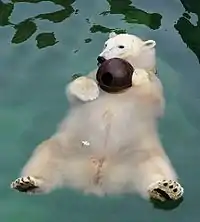
The Durham Family Bear Canyon opened in 1989 at a cost of $1.4 million.[30] The canyon had a large 30,000-U.S.-gallon (25,000 imp gal; 110,000 L) tank for polar bears. Having previously housed four bear species - the Polar bear, the American black bear, the Sun bear and the Spectacled bear, it was closed and demolished in 2018 to make room for Owen Coastal Shores.
Red Barn Park
The Red Barn Park was a petting zoo that opened in 1966.[31] It included numerous domesticated animals including goats and cattle and was particularly noteworthy because of the large red barn that could be found in the area. It was demolished in 2018 and replaced with the Glacier Bay Landing area which opened in the spring of 2019.[31] Many of the animals found in the exhibit were transferred to the Children's Adventure Trails.
Research
The Bill and Berniece Grewcock Center for Conservation and Research is a world-class research center at the zoo. The center has discovered several new species. The world's first in vitro-fertilized ("test-tube") gorilla resides at the zoo. The world's first artificially inseminated tiger was born in Omaha in 1991, followed by the world's first artificially inseminated gaur. The original 16,448-square-foot (1,528.1 m2) facility was constructed in 1996.[32] In 2006, it underwent a $6 million expansion which brings the total space to 32,000 sq ft (3,000 m2).[32]
The research center focuses on six areas:
- Education and technology transfer
- Conservation medicine
- Molecular genetics
- Reproductive physiology
- Horticulture
- Nutrition
Mouse lemurs
A study led by Edward Louis, a conservation geneticist at the zoo, identified three new mouse lemurs (Simmons' mouse lemur, Mittermeier's mouse lemur, and Jolly's mouse lemur) with the first named after Lee Simmons, the zoo's director.[33][34][35]
Rides and transportation
Railroad
The Omaha Zoo Railroad is a 2.5-mile (4.0 km), 2 ft 6 in (762 mm) narrow gauge train that loops through the zoo. The railroad began operations on July 22, 1968, after the track was laid down by the Union Pacific railroad. The train operates with one of two oil-powered steam locomotives. Riva is about twice as powerful (although is almost 80 years older) as the #119 and is regularly used on weekends when more visitors are present. The #119 is the original locomotive for the zoo. A new diesel locomotive arrived in September 2008. This diesel is a 2-axle Plymouth locomotive and is used for switching operations of the passenger cars and other railroad-related projects.
 1968 #119
1968 #119 1890 "Riva", CFR #395-104
1890 "Riva", CFR #395-104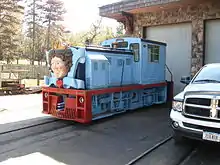 "VIRGIE"
"VIRGIE"
Tram
The tram is a trackless tram that drives on the walkway paths around the zoo. It has four stops:
- By the Desert Dome (top of the hill)
- Between the elephant/zebra yard and pygmy goat kraal
- By the playground near the sea lions
- Between the carousel and Alaskan Adventure splashpad
Skyfari
Omaha's Henry Doorly Zoo and Aquarium opened the Skyfari in 2009. It is an aerial tram that runs from one stop at the Butterfly and Insect Pavilion to the lion platform. It goes over the African veldt (ostriches and giraffes), cheetahs, the railroad tracks, the Garden of the Senses, the koi lagoon, and the lions.
Carousel
A carousel is available on which visitors can ride handcrafted recreations of wild animals.
Educational programs
The zoo offers many educational programs. The activities include school-involved programs, special "edzoocational" programs, zoo internships, animal-adoption, and volunteer work. Several programs include field trips, guided tours, educator workshops, Little Lion's Preschool, and two-way internet video conferencing to bring the zoo to the classroom. The edzoocational programs are educational programs that are taught in a nontraditional way. These programs include overnight camp-outs at the zoo, scouting programs, summer camps, birthday parties, and on-site speakers.
References
- "Omaha's Henry Doorly Zoo". omahazoo.com. April 2007. Archived from the original on 2008-08-25. Retrieved 2019-02-03.
- "Currently Accredited Zoos and Aquariums". aza.org. AZA. Retrieved 5 September 2010.
- "Zoos and Aquariums of the World". waza.org. WAZA. Retrieved 5 September 2010.
- "Omaha's Henry Doorly Zoo and Aquarium". Omaha's Henry Doorly Zoo and Aquarium.
- "Information" Archived 2008-09-12 at the Wayback Machine, Omaha's Henry Doorly Zoo. Retrieved 5/8/08.
- Chuck Thompson (6 August 2014). "And the world's best zoo is ..." CNN. Retrieved 7 August 2014.
- "Best of America: Best Zoo". Reader's Digest. 2008-05-09. Archived from the original on 2008-05-09. Retrieved 2019-02-03.CS1 maint: unfit URL (link)
- "Omaha Henry Doorly Zoo" Archived 2008-06-02 at the Wayback Machine. VisitNebraska.org. Retrieved 5/2/08.
- "Kiewit - Henry Doorly Zoo Desert Dome - Omaha, NE". Kiewit Corporation. 2008-06-21. Archived from the original on 2008-06-21. Retrieved 2019-02-03.
- "Attractions in Omaha", The New York Times. Retrieved 5/8/08.
- "History" Archived 2008-08-23 at the Wayback Machine, Henry Doorly Zoo website.
- "Omaha's Henry Doorly Zoo and Aquarium". www.omahazoo.com. Retrieved 2015-08-28.
- "TIMELINE: Six African elephants arrive in Omaha -- March 11, 2016". KETV. 12 March 2016.
- https://www.ketv.com/article/omaha-zoo-elephant-unexpectedly-dies/12194039
- "Owen Sea Lion Shores". Retrieved September 4, 2020.
- African Grasslands retrieved on January 3, 2019.
- https://www.wowt.com/content/news/African-elephant-bull-on-his-way-to-Omaha-zoo-from-Alabama-510522631.html
- Asian Highlands retrieved on January 3, 2019.
- writer, Chris Peters World-Herald staff. "What to expect from Omaha zoo's Asian Highlands, which opens in part Thursday". Omaha.com.
- "Omaha's Henry Doorly Zoo". Archived from the original on 2008-04-22. Retrieved 2020-01-12.
- "Omaha's Henry Doorly Zoo". Archived from the original on 2008-04-22. Retrieved 2020-01-12.
- Henry Doorly Zoo: Scott Kingdoms of the Seas Aquarium. Retrieved 18 January 2014
- "Omaha's Henry Doorly Zoo". Archived from the original on 2008-04-22. Retrieved 2020-01-12.
- "Omaha's Henry Doorly Zoo". Archived from the original on 2006-10-16. Retrieved 2019-02-03.
- Lied Jungle Archived 2006-10-16 at the Wayback Machine. Omaha Henry Doorly Zoo and Aquarium website.
- Service, Chris Peters BH News. "A new $22.5 million sea lion exhibit is coming to the Henry Doorly Zoo". The Daily Nonpareil - Council Bluffs, Iowa.
- Henry Doorly Zoo's Aviary Archived 2007-10-10 at the Wayback Machine retrieved on November 27, 2008.
- "Omaha's Henry Doorly Zoo". Archived from the original on 2008-04-22. Retrieved 2020-01-12.
- https://www.omaha.com/living/halfway-through-its-master-plan-the-henry-doorly-zoo-has/article_e89c818d-e26a-5ff0-90a5-cd71bbd31c0b.html
- "Omaha's Henry Doorly Zoo". Archived from the original on 2008-04-22. Retrieved 2020-01-12.
- https://www.omaha.com/lifestyles/omaha-zoo-closes-oldest-exhibit-red-barn-petting-area-plans/article_adcf91c1-4c0f-5e49-a859-d54eec3440b0.html
- "Omaha's Henry Doorly Zoo". Archived from the original on 2008-09-12. Retrieved 2020-01-12.
- Edward E. Louis; Melissa S. Coles; Rambinintsoa Andriantompohavana; Julie A. Sommer; Shannon E. Engberg; John R. Zaonarivelo; Mireya I. Mayor; Rick A. Brenneman (2006). "Revision of the Mouse Lemurs (Microcebus) of Eastern Madagascar". International Journal of Primatology. 27 (2): 347–389. doi:10.1007/s10764-006-9036-1. S2CID 56920.
- Three new lemurs take a bow in Madagascar - Reuters News Release
- Three New Lemurs Discovered, Add to Madagascar's Diversity, National Geographic News, June 26, 2006.
External links
| Wikimedia Commons has media related to Henry Doorly Zoo. |
